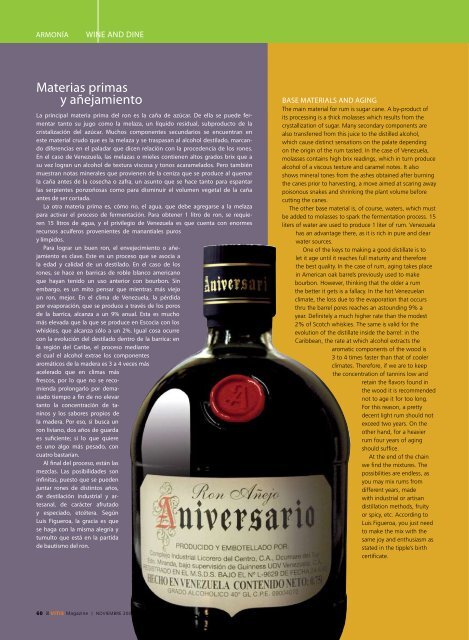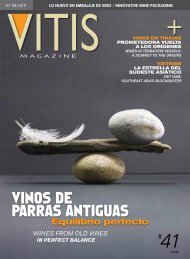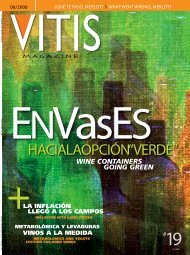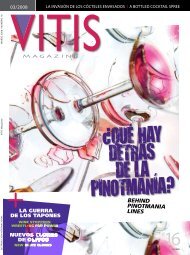You also want an ePaper? Increase the reach of your titles
YUMPU automatically turns print PDFs into web optimized ePapers that Google loves.
armonía wine and dine<br />
materias primas<br />
y añejamiento<br />
la principal materia prima del ron es la caña de azúcar. de ella se puede fermentar<br />
tanto su jugo como la melaza, un líquido residual, subproducto de la<br />
cristalización del azúcar. muchos componentes secundarios se encuentran en<br />
este material crudo que es la melaza y se traspasan al alcohol destilado, marcando<br />
diferencias en el paladar que dicen relación con la procedencia de los rones.<br />
en el caso de Venezuela, las melazas o mieles contienen altos grados brix que a<br />
su vez logran un alcohol de textura viscosa y tonos acaramelados. pero también<br />
muestran notas minerales que provienen de la ceniza que se produce al quemar<br />
la caña antes de la cosecha o zafra, un asunto que se hace tanto para espantar<br />
las serpientes ponzoñosas como para disminuir el volumen vegetal de la caña<br />
antes de ser cortada.<br />
la otra materia prima es, cómo no, el agua, que debe agregarse a la melaza<br />
para activar el proceso de fermentación. para obtener 1 litro de ron, se requieren<br />
15 litros de agua, y el privilegio de Venezuela es que cuenta con enormes<br />
recursos acuíferos provenientes de manantiales puros<br />
y límpidos.<br />
para lograr un buen ron, el envejecimiento o añejamiento<br />
es clave. este es un proceso que se asocia a<br />
la edad y calidad de un destilado. en el caso de los<br />
rones, se hace en barricas de roble blanco americano<br />
que hayan tenido un uso anterior con bourbon. Sin<br />
embargo, es un mito pensar que mientras más viejo<br />
un ron, mejor. en el clima de Venezuela, la pérdida<br />
por evaporación, que se produce a través de los poros<br />
de la barrica, alcanza a un 9% anual. esta es mucho<br />
más elevada que la que se produce en escocia con los<br />
whiskies, que alcanza sólo a un 2%. igual cosa ocurre<br />
con la evolución del destilado dentro de la barrica: en<br />
la región del Caribe, el proceso mediante<br />
el cual el alcohol extrae los componentes<br />
aromáticos de la madera es 3 a 4 veces más<br />
acelerado que en climas más<br />
frescos, por lo que no se recomienda<br />
prolongarlo por demasiado<br />
tiempo a fin de no elevar<br />
tanto la concentración de taninos<br />
y los sabores propios de<br />
la madera. por eso, si busca un<br />
ron liviano, dos años de guarda<br />
es suficiente; si lo que quiere<br />
es uno algo más pesado, con<br />
cuatro bastarían.<br />
al final del proceso, están las<br />
mezclas. las posibilidades son<br />
infinitas, puesto que se pueden<br />
juntar rones de distintos años,<br />
de destilación industrial y artesanal,<br />
de carácter afrutado<br />
y especiado, etcétera. Según<br />
luis Figueroa, la gracia es que<br />
se haga con la misma alegría y<br />
tumulto que está en la partida<br />
de bautismo del ron.<br />
60 ▼ <strong>Vitis</strong> <strong>Magazine</strong> l novieMbre 2008<br />
BaSe materialS and aGinG<br />
The main material for rum is sugar cane. A by-product of<br />
its processing is a thick molasses which results from the<br />
crystallization of sugar. Many secondary components are<br />
also transferred from this juice to the distilled alcohol,<br />
which cause distinct sensations on the palate depending<br />
on the origin of the rum tasted. in the case of venezuela,<br />
molasses contains high brix readings, which in turn produce<br />
alcohol of a viscous texture and caramel notes. it also<br />
shows mineral tones from the ashes obtained after burning<br />
the canes prior to harvesting, a move aimed at scaring away<br />
poisonous snakes and shrinking the plant volume before<br />
cutting the canes.<br />
The other base material is, of course, waters, which must<br />
be added to molasses to spark the fermentation process. 15<br />
liters of water are used to produce 1 liter of rum. venezuela<br />
has an advantage there, as it is rich in pure and clear<br />
water sources.<br />
one of the keys to making a good distillate is to<br />
let it age until it reaches full maturity and therefore<br />
the best quality. in the case of rum, aging takes place<br />
in American oak barrels previously used to make<br />
bourbon. However, thinking that the older a rum<br />
the better it gets is a fallacy. in the hot venezuelan<br />
climate, the loss due to the evaporation that occurs<br />
thru the barrel pores reaches an astounding 9% a<br />
year. Definitely a much higher rate than the modest<br />
2% of Scotch whiskies. The same is valid for the<br />
evolution of the distillate inside the barrel: in the<br />
Caribbean, the rate at which alcohol extracts the<br />
aromatic components of the wood is<br />
3 to 4 times faster than that of cooler<br />
climates. Therefore, if we are to keep<br />
the concentration of tannins low and<br />
retain the flavors found in<br />
the wood it is recommended<br />
not to age it for too long.<br />
For this reason, a pretty<br />
decent light rum should not<br />
exceed two years. on the<br />
other hand, for a heavier<br />
rum four years of aging<br />
should suffice.<br />
At the end of the chain<br />
we find the mixtures. The<br />
possibilities are endless, as<br />
you may mix rums from<br />
different years, made<br />
with industrial or artisan<br />
distillation methods, fruity<br />
or spicy, etc. According to<br />
Luis Figueroa, you just need<br />
to make the mix with the<br />
same joy and enthusiasm as<br />
stated in the tipple’s birth<br />
certificate.






